Super quick and easy bacon kimchi fried udon that uses less than 10 ingredients to create a satisfying meal that’s loaded with flavor. The thick, chewy udon is stir fried with crispy bacon and tender kale, brought together with a spicy sauce. It’s a perfect one-pan meal for any time of day!
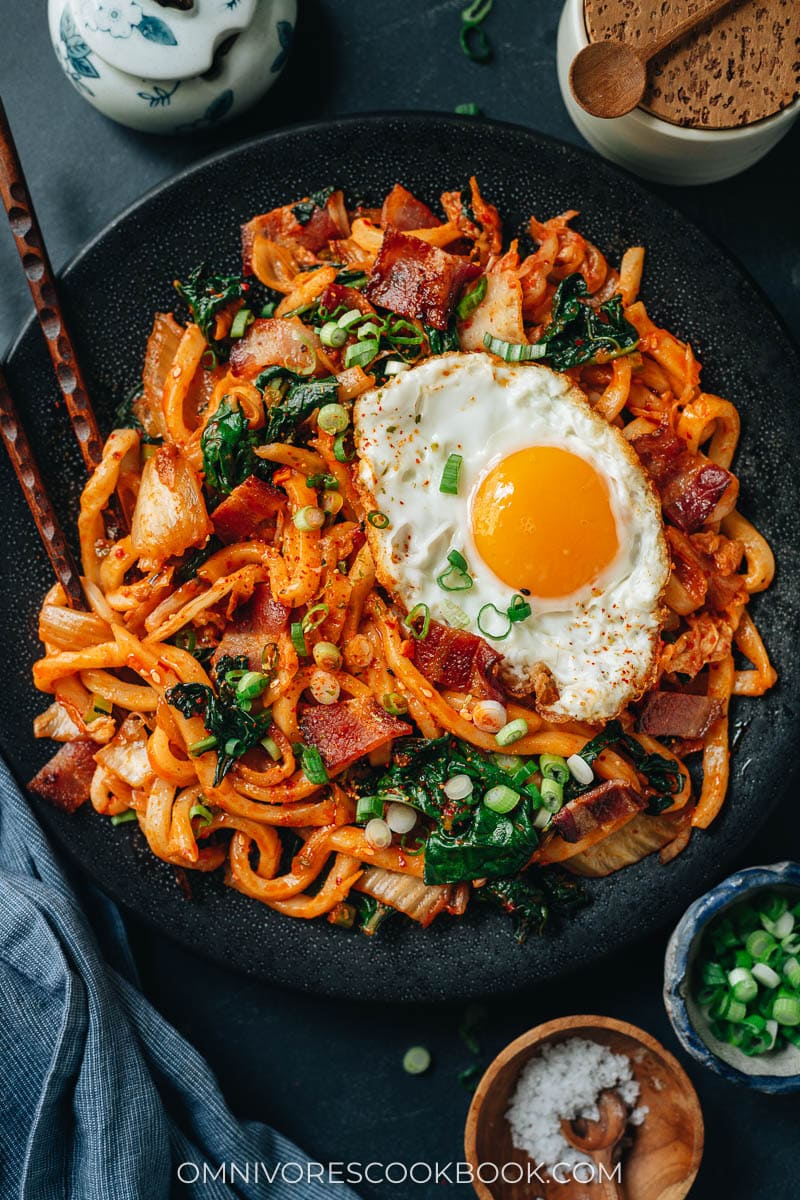
If you’re looking for a fast and simple one-bowl dinner, this bacon kimchi fried noodle dish is the perfect option. It uses minimal ingredients and prep to create the boldest flavor using the magic ingredient kimchi.
My husband and I both love kimchi and we always keep a huge jar of it in the fridge. I’ve posted many kimchi recipes in the past, such as Easy Kimchi Fried Rice, Kimchi Stew with Tofu and Meatballs, Egg and Kimchi Quesadilla, and Easy Kimchi Pizza.
The magic about kimchi is, because it is packed with flavor and texture itself, you don’t need a ton of other ingredients to make your dish super flavorful. And of course, who can say no to crispy bacon!
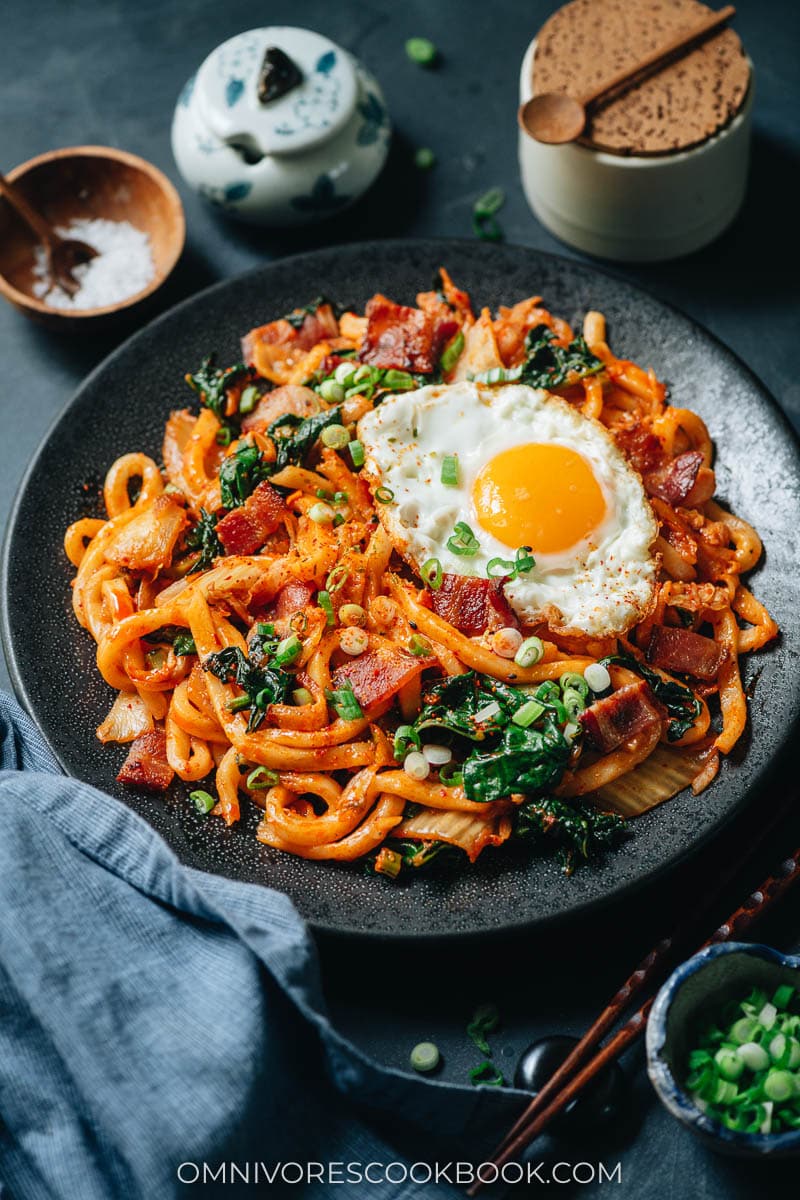
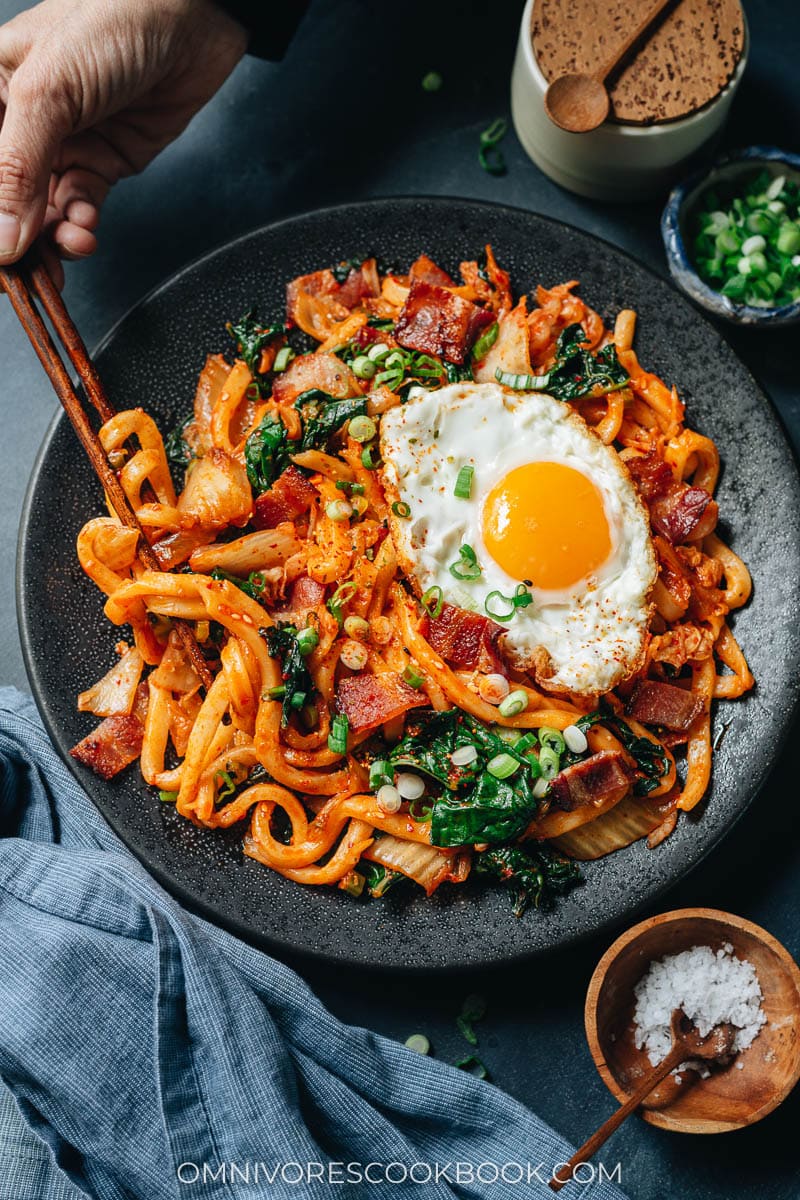
That Noodle Life Cookbook
Before jumping into the recipe, I want to give a shout out for the new cookbook That Noodle Life from Mike Le & Stephanie Le. Stephanie Le is the blogger behind I Am a Food Blog, sharing colorful and simple recipes that will brighten your day. I was super excited to receive her latest cookbook, which focuses on everything about noodles. It has a lot of fun recipes from spaghetti to ramen, inspired by many cultures including those in Asia, Italy, the US, and Mexico. You will find recipes such as Oven-Roasted Yaki Udon Al Pastor, Roasted Bone Marrow and Beef Brisket Pho, and Philly Cheesesteak Instant Mazemen. And this kimchi fried udon recipe is from this cookbook, with some tiny modifications made to suit my own preferences.
Bacon kimchi fried udon ingredients
Gochujang
Gochujang is a thick chili paste that is spicy, savory, and a bit sweet. Made with red chile pepper flakes, glutinous rice (also known as sticky rice), fermented soybeans, and salt. It’s fermented, sometimes for years, and is packed with umami that will enhance your dish with more than just spice. It is quite similar to Chinese Doubanjiang, but sweeter. These days you can easily find it in most Asian markets and on Amazon. Even many regular grocery stores now stock it in the ethnic aisle. Once opened, you should store gochujang in the fridge and it will last a long time, about 1 year or so.
Udon noodles and alternatives
Stephanie mentioned in her book that it’s important to select a high quality udon noodle – Sanuki style udon if possible. It is a cooked frozen udon that you can directly use in a stir fry after thawing. A high quality udon should be extra thick and chewy. On the other hand, some of the lower quality ones can get very mushy once heated up.
If you cannot find a good udon noodle, I would recommend using spaghetti or bucatini, which have a chewy texture that works well for this dish.
Mise en place
When you’re ready to cook, your table should have:
- Mixed gochujang and soy sauce
- Kimchi
- Thawed (or cooked) udon noodles
- Kale, with stem and leaves separated (I like to reserve the stem and slice it into very thin slices so it cooks evenly and quickly)
- Cooked and chopped bacon
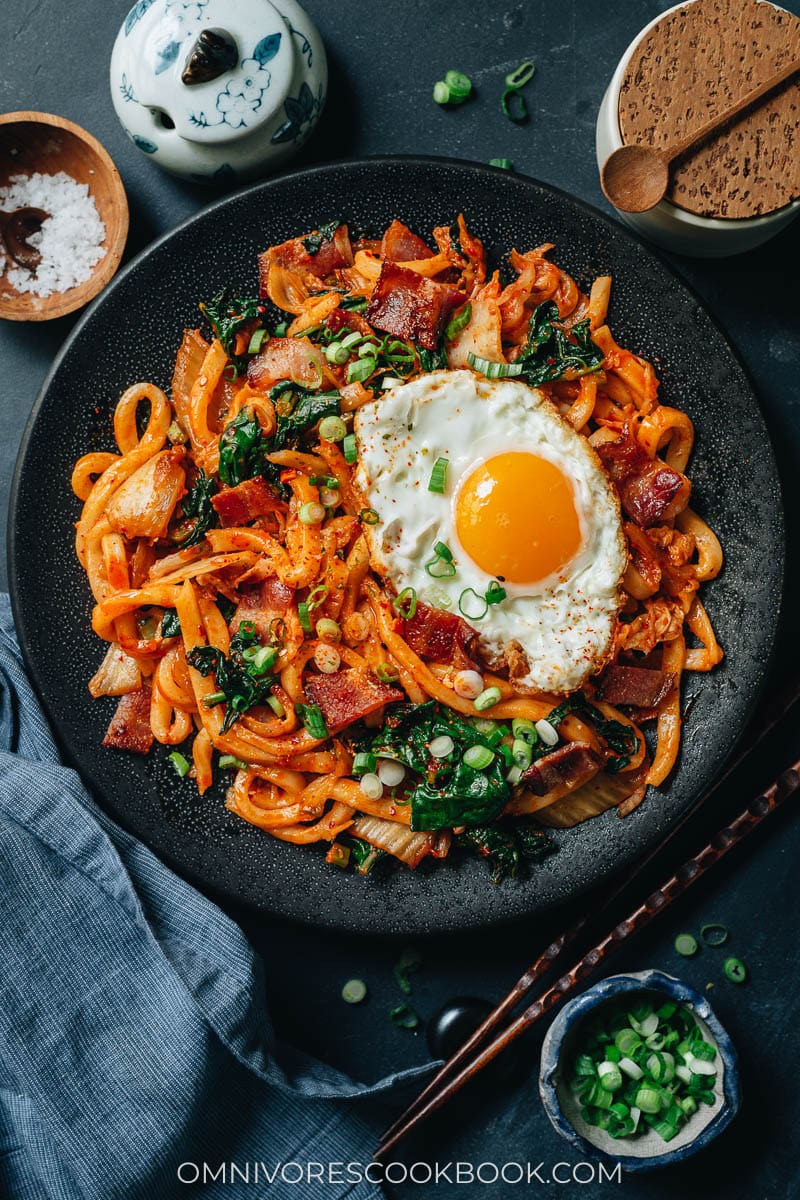
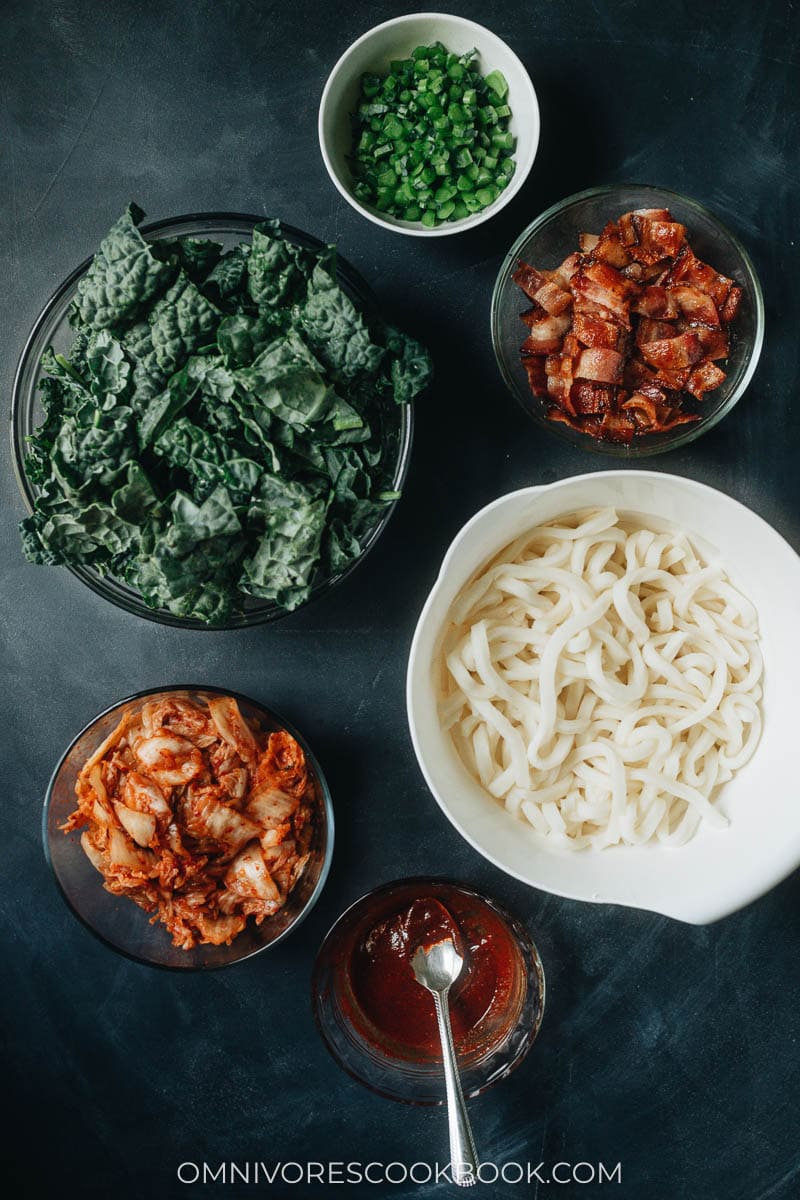
Tip for fast prep
I prefer to get the bacon going while preparing the other ingredients because frying bacon takes a bit of time. I like to fry bacon using medium-low heat, to render out as much fat as I can for a crispy result. It also creates less splatter this way.
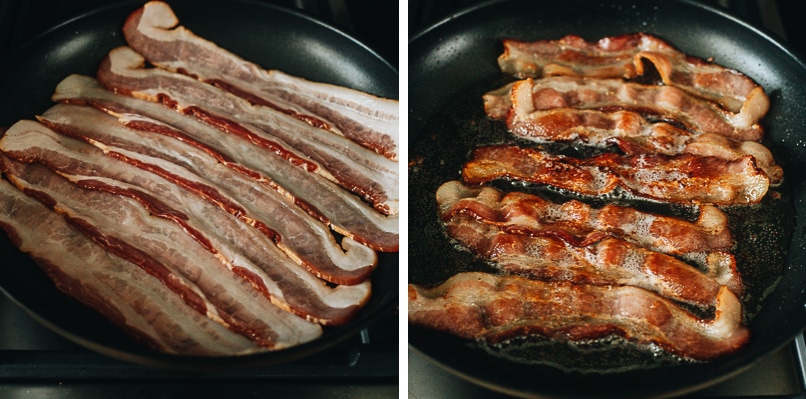
How to make bacon kimchi fried udon
- Cook the kimchi and kale stems
- Add the kale leaves and continue cooking
- Stir in the gochujang mixture
- Add the udon and cooked bacon
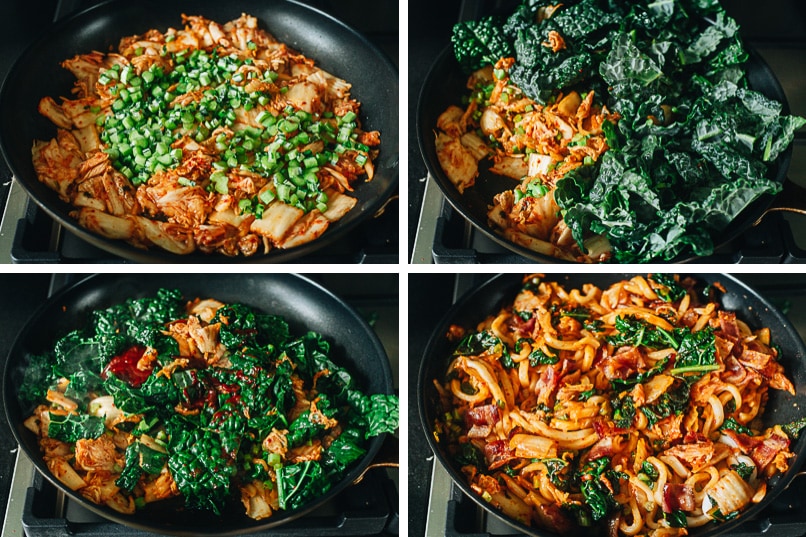
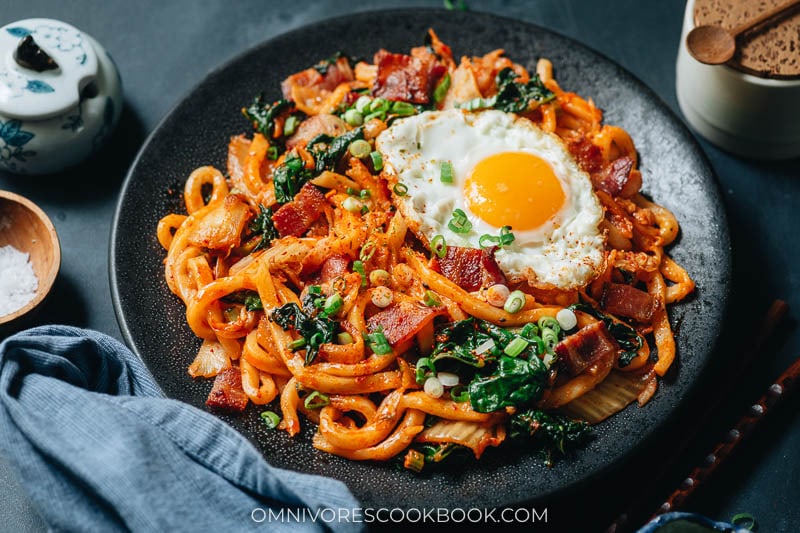
That’s it! It takes no time to put together and it’s so easy to make. And don’t forget to put an egg on it to make it extra tasty.
I hope you enjoy this super fast and delicious dish! And don’t forget to check out the cookbook That Noodle Life if you like noodles! 🙂
Other delicious Korean recipes
- Sundubu Jjigae (Korean Soft Tofu Stew)
- Korean Seafood Pancake (Haemul Pajeon)
- Korean Instant Pot Short Ribs (Galbi Jjim)
- Japchae (Korean Sweet Potato Noodles)
- Oven Fried Chicken Wings with Korean BBQ Sauce
75 fun, easy, comforting recipes that go way beyond spaghetti and ramen. Inspired by the noodle-crazed cuisines of Asia, Italy, and the American melting pot, these recipes dish up high-impact, slurpable flavor and minimal fuss.
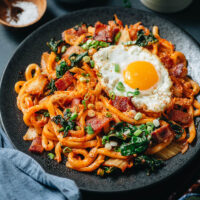
Bacon Kimchi Fried Udon
Ingredients
- 8 oz (225 g) bacon (preferably thick cut)
- 2 blocks (8 oz. / 225 g each) frozen udon (or 6 oz. / 170 g spaghetti or bucatini, cooked until al dente)
- 1/2 bunch (150 g) kale , stem thinly sliced and leaves cut into large bite-size pieces
- 2 cups (200 g) kimchi , chopped (plus 2 tablespoons kimchi juice)
- 1 1/2 tablespoons gochujang
- 2 teaspoons soy sauce
- 2 tablespoons peanut oil (or unsalted butter)
Topping options
- Raw egg yolks (or sunny side-up eggs)
- Crispy nori sheets , cut into small pieces
- Shichimi Togarashi
- Sliced green onions
Instructions
- Prepare the other ingredients while cooking the bacon. Spread the bacon in a large skillet without overlapping. Heat over medium heat until sizzling. Turn to medium-low heat. Cook, flipping occasionally, until golden brown and crispy, 6 to 10 minutes. Once done, transfer the bacon to a plate lined with paper towels. When the bacon is cool enough to handle, slice it into 1” (2.5 cm) pieces and set aside. Wipe the skillet clean with paper towels.
- Meanwhile, fill a large bowl with warm tap water and add the frozen udon. Once the noodles are loosened and warmed, 2 to 3 minutes, drain well and set aside.
- Add the gochujang and soy sauce in a small bowl. Stir until well combined.
- Return the pan to medium heat and add the peanut oil. Add the chopped kimchi and kale stems. Stir and cook for 1 minute. Add the kale leaves. Cook for 1 to 2 minutes until the kale is wilted.
- Add the oil and the gochujang soy sauce mixture. Stir to mix everything well and evenly coated. Remove the pan from the heat.
- Add the noodles, kimchi juice and bacon. Cook over low heat and toss constantly, until the noodles are coated, 1 to 2 minutes.
- Top the noodles with your preferred toppings and serve hot as a main dish.













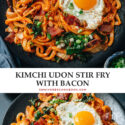
This was fantastic! This is an absolute do again. I used baby bok choy instead of kale. I figure any greens would do. I didn’t find shichimi tagorashi, but I found nanami togarashi, which is also really great on Orange Chicken. This is a great recipe and a total do-again. Thank you for sharing!
So happy to hear you liked this one! Yes, bok choy totally works and I think it might even tastes better in this recipe. Thank you for leaving a positive review 🙂
Easy and soooo flavorful!
Loved it!! With the hot weather I didn’t have much appetite but this went down nicely. Thank you for the recipe.